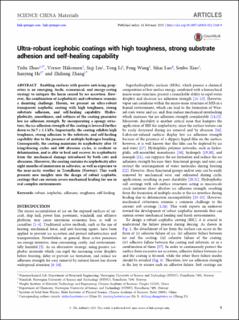Ultra-robust icephobic coatings with high toughness, strong substrate adhesion and self-healing capability
Zhuo, Yizhi; Håkonsen, Verner; Liu, Siqi; Li, Tong; Wang, Feng; Luo, Sihai; Xiao, Senbo; He, Jianying; Zhang, Zhiliang
Peer reviewed, Journal article
Published version
Permanent lenke
https://hdl.handle.net/11250/3059221Utgivelsesdato
2022Metadata
Vis full innførselSamlinger
- Institutt for kjemi [1386]
- Institutt for konstruksjonsteknikk [2470]
- Publikasjoner fra CRIStin - NTNU [37703]
Originalversjon
10.1007/s40843-022-2340-9Sammendrag
Enabling surfaces with passive anti-icing properties is an emerging, facile, economical, and energy-saving strategy to mitigate the harm caused by ice accretion. However, the combination of icephobicity and robustness still remains a daunting challenge. Herein, we present an ultra-robust transparent icephobic coating with simultaneous high toughness, strong substrate adhesion, and self-healing capability. Hydrophobicity, combined with smoothness and softness of the coating warrant low ice adhesion strength. Moreover, by incorporating a spongy structure, the ice adhesion strength of the coating is lowered further down to 26.7 ± 1.1 kPa. Importantly, the coating exhibits high toughness, strong adhesion to substrate, and self-healing capability due to the presence of multiple hydrogen bonding. Consequently, the coating maintains its icephobicity after 35 icing/deicing cycles and 600 abrasion cycles, is resilient to delamination, and is able heal and recover its icephobicity from the mechanical damage introduced by both cuts and abrasions. Moreover, the coating maintains icephobicity after 8 months of immersion in saltwater, as well as exposure to near-arctic weather in Trondheim (Norway). This work presents new insights into the design of robust icephobic coatings that can sustain severe mechanical loading for use in real complex environments.

